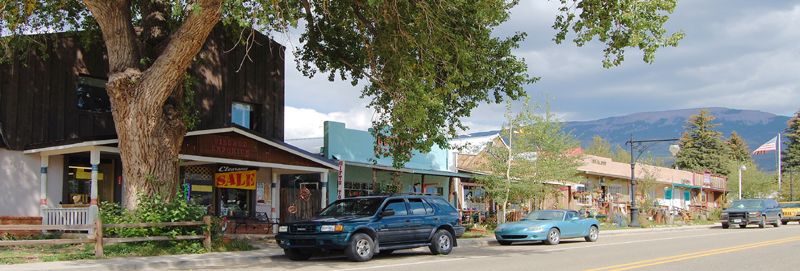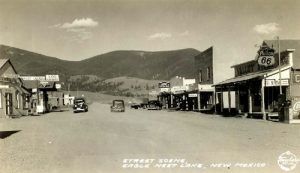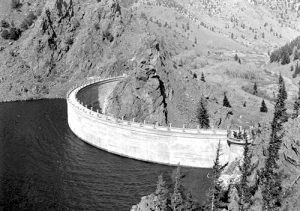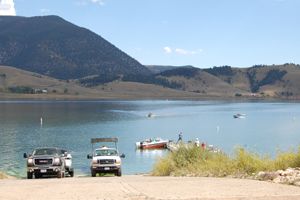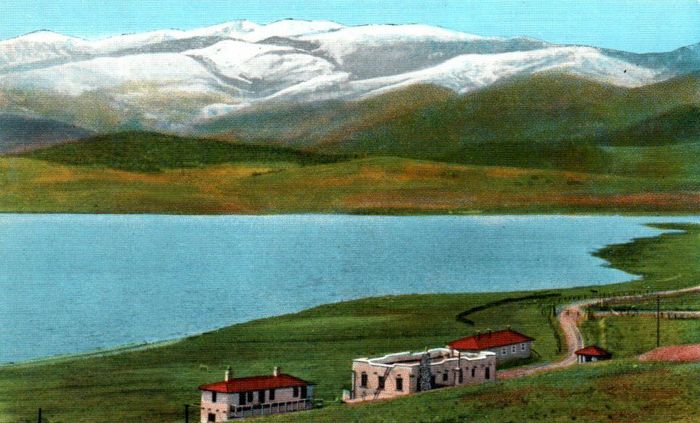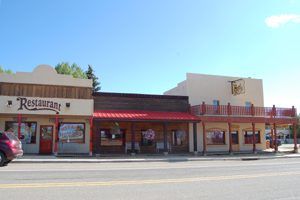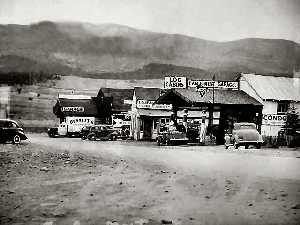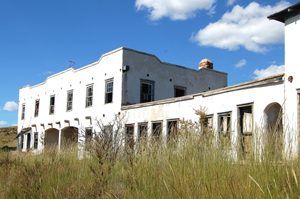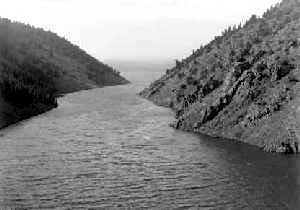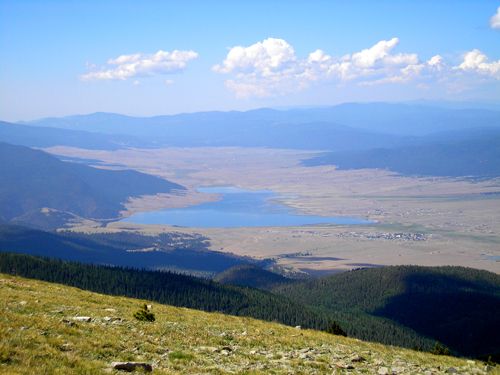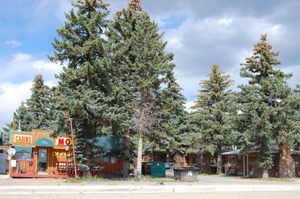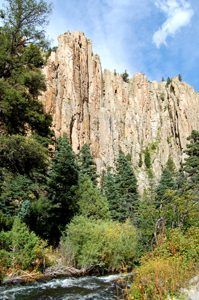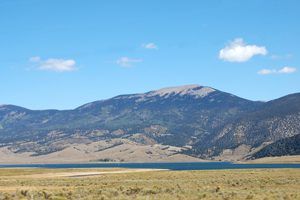Eagle Nest, New Mexico, is located in the Moreno Valley amid the beautiful Sangre de Cristo Mountains in northeast New Mexico. Nestled between the state’s two highest peaks – Baldy Mountain (12,441 feet) and Wheeler Peak (13,161 feet), it sits at the junction of US Hwy 64 and State Hwy 38. High above sea level, at 8,300 feet, the village rests on the western slope of Baldy and Touch Me Not Mountains, an area rich in Gold Rush history.
Before the miners, the area was called home by the Ute and Jicarilla Apache Indians, who roamed the area searching for game and golden feathers for ceremonial worship. When Elizabethtown, just 5 ½ miles north, was in its heyday, the Eagle Nest area mainly was used for ranching and farming.
In 1873 Charles and Frank Springer founded the C.S. Ranch on the banks of the Cimarron River, and in 1907 they applied for a permit to build the Eagle Nest Dam. It was almost ten years before the Springers could hire the engineering firm of Bartlett and Ranney of San Antonio, Texas, to design and build the dam. Finally, in 1916 construction on the dam was begun and was completed in 1918 to store the surplus waters of the Cimarron River for power plants, mining, and irrigation. Most of the labor for building the dam was provided by the Taos Pueblo Indians. The largest privately constructed dam in the United States, the concrete structure is 400 feet wide, stands 140 feet above the river bed, and is 9.5 feet thick at its crest and 45.2 feet thick at its base. Supposedly, eagles built nests on the sides of the new dam, and that’s how it got its name.
The dam created Eagle Nest Lake, which varies between 1,500 and 3,000 surface acres, depending upon weather cycles. Surrounded by rolling pasture and stunning mountains, the fishermen began to arrive when the lake was stocked with trout. Along with the fishermen, entrepreneurs also arrived, building businesses and transforming the quiet farming community into a tourist mecca, providing entertainment to the visiting cowboys, fishermen, and other tourists.
One of the biggest industries was cutting and selling ice from the lake. T.D. Neal hired men to drive out upon the lake and cut block ice stored in ice houses filled with sawdust. Jobs were scarce in the area, and many families survived the winters by ice cutting and trapping.
In the 1920s, illegal gambling was introduced to the area. Eagle Nest became popular along the road from Santa Fe to Raton, where politicians and other travelers attended the horse races. A favorite stopover for the dignitaries was said to have caused quite a stir with their gambling, drinking, and dancing.
In 1927, Walter Gant, an oilman from Oklahoma, hired a businessman by the name of William B. Tyer to oversee the construction of the grandest resort that Eagle Nest had ever seen — the Eagle Nest Lodge. Bill Tyer lived in a cabin on the Gant property and oversaw the many details of building the luxurious lodge. When it was completed, Bill Tyer stayed on to manage the Eagle Nest Lodge, which featured 12 rooms, a lounge, a restaurant, horseback riding, fishing, and hunting expeditions for the many travelers who stopped to enjoy its magnificent view of Eagle Nest Lake. Considered the finest lodge for miles, it soon expanded to include a guest annex that featured five studio units with bathrooms and kitchenettes. They also connected the main building to the Casa Loma via a walkway/lounge called the Loafer’s Lounge.
The local saloons heartedly welcomed the travelers, rolling slot machines out upon the boardwalk early in the morning to entice the gamblers. Judge Neblett, for whom the Colin Neblett Wildlife Area is named, was a frequent visitor, as well as several governors. Though gambling was illegal, it was obviously overlooked by the politicians. It has been said by several locals that when illegal gambling was first introduced to Eagle Nest in the 1920s, the local Sheriff owned many of the slot machines in Eagle Nest, Red River, and Colfax County. However, since we first published this story in the summer of 2003, we have heard from Jerry Ficklin, a local historian and writer, who once lived in Eagle Nest and spent many summers there between the years 1945 and 1960, that this “tidbit” is nothing more than a legend with no documented support.
The El Monte Hotel (now the Laguna Vista), Doughbelly’s Cafe, and The Gold Pan were said to have offered roulette, gaming tables, and slot machines. Slot machines were also found in many of the stores.
Eagle Nest was in its heyday during the 1930s, with disputes often resulting in shots fired back and forth across Main Street. Reportedly one saloon owner, along the road that travels north from Eagle Nest to Idlewild, was known to provide free wine to those who came through its doors. The free pouring of wine would inevitably lead to fights and discord among the rowdy customers, which the saloon “advertised” as free entertainment.
The town was immobilized in the winter as the wind gusted across the lake, locking the inhabitants indoors. The area would flood in the spring with fishermen anxious to test their rods in the lake. T.D. Neal started the annual Eagle Nest Fish Fry to promote the lake, which drew two to three thousand winter-weary souls from all over the region. In 1936, the cars were said to have been lined up for miles from the old Eagle Nest Lodge to the Cloverleaf Motel.
Gambling continued to thrive in the early 1940s. Unregulated, many locals tell stories that the games were rigged as local shills were called in to sit and play until enough “victims” arrived to fill the table. Some also say the roulette tables were rigged and the cards and dice marked. This, too, has been disputed by author/historian Jerry Ficklin, as he knew many of the owners and managers of the gaming establishments during the 1940s. Most likely, this is nothing more than idle gossip that has since become a “legend” over the many years that have passed. However, one interesting tidbit of information regarding the games of chance is in the case of a poker game, where the 700-acre Moreno Ranch was lost. In 1944, the ranch was purchased from the winner by the Deuel family.
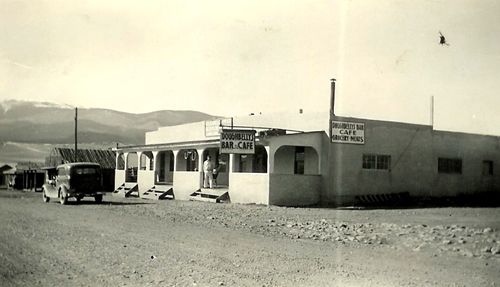
Dougbellys Bar, Eagle Nest, New Mexico.
It was sometime during this period that El Monte’s name was changed to the Laguna Vista Lodge and was operated by a couple named Gene and Pearl Wilson. At this time, the Wilsons often had to protect their gambling profits when transporting them from the saloon to their living quarters by arming themselves with guns.
By this time, Doughbelly’s Cafe was owned by Johnny Fincher, who continued to operate slot machines, dice tables, and roulette in the establishment that he called the Eagle Nest Inn. The Eagle Nest Motor Court was down the street, with several adobe cabins and gas pumps sitting out front. While the cabins are still there today, called the Lucky Shoe Motel, the old-fashioned gas pumps (seen below) are long gone.
Finally, the town was busted for illegal gambling in the late 1940s when authorities took axes to the slot machines, busting them up and leaving them in pieces in the streets. It was said that Dave Mutz’s uncle, Joe Necas, rummaged in the dirt after the destruction of the machines and found enough change to buy himself a new pair of boots.
Reportedly, some of the slot machine owners heard about the bust before it happened and dumped their slot machines in the lake to avoid prosecution. Many people told us that on a clear day, you can still see signs of them at the foot of Eagle Nest dam in low water. Even after the bust, gambling continued in the back rooms of some of the businesses, and slot machines were said to have been hidden in the bathrooms of many establishments.
In 1944, during World War II and the rationing of tires and gasoline, the Eagle Nest Lodge had few visitors and closed its doors. Bill Tyer, along with his wife Hazel, and new baby girl, Ann, returned home to Ardmore, Oklahoma. The Gant family then utilized the magnificent Eagle Nest Lodge as a resort for several decades until it was abandoned.
In the early 1950s, Bob and Edith Sullivan purchased the Laguna Vista Lodge from the Wilsons, leasing the restaurant to Walter Ragsdales, who operated it for several years*. In 1964, the “new” hotel was built next to the original hotel for additional guests. In 1971, Bert Clemens bought the Laguna Vista Lodge from the Sullivans and continues to operate it to this day.
In 1977 and 1978, the lake was closed due to low water levels, which caused severe economic problems for the area residents. Then in 1979, a near-record spring run-off allowed the lake to be reopened.
In 1980, the C.S. Cattle Co provided a 20-year lake lease to the New Mexico Department of Game and Fish. During the summer, it became a training ground for rowing crews and continued as a welcome retreat to the many anglers. Ice-boating and ice-fishing were popular in winter as the winter ice thickness often reached two and one-half to three feet.
However, several years before the lease expiration in 2000, the C.S. Cattle Company determined that they were not interested in renewing the lease and offered to sell the lake and several thousand acres of land to the State of New Mexico for $20 million.
In response, the New Mexico Legislature allocated $15 million of $20 million towards the purchase of the lake and reviewed proposals for over six years. Still, in February 2002, the entire plan was scrapped. Manny Aragon, a Democrat from Albuquerque and Senate Majority Leader, proposed significant changes to New Mexico’s spending priorities, and the Senate agreed. Aragon had proposed to spend $2.5 million to rehabilitate the dam at Eagle Nest in exchange for obtaining a long-term lease of the lake. But according to Kirk Davis, there was never an option for a lease, and the deal was dead. The Senate eliminated financing to buy the lake and redirected the $15 million to various other water supply projects in the state. Aragon said of the lake purchase, “This is the most ludicrous investment of limited resources that one could think of in 2002.”
Finally, on May 24, 2002, the Legislature voted to purchase the lake, and the residents breathed a collective sigh of relief. The state once again resumed the operations of the lake, this time under an interim lease that ended when the sale of the lake was finalized in October 2002. The lake is now an official State Park with plans for improvements, including picnic and camping areas.
Les Davis, Kirk Davis’ father, had envisioned state ownership of the lake. “He always wanted the citizens of New Mexico to have the lake. That was the driving force, really, behind sticking with the state on this. He didn’t want to see it developed,” Kirk Davis said.
The 2,200-acre Eagle Nest Lake offers excellent fishing. In the winter, anglers wander out onto its frozen surface, drill a hole and try their hand at landing kokanee salmon, rainbow trout, and cutthroat trout. Ice fishing usually begins in January, and open-water fishing starts in April.
Approximately 30,000 anglers visit Eagle Nest Lake annually, and thousands more who love the 13,000-foot Sangre de Cristo mountains overlooking the lake. Though camping is not currently allowed at the lake, the Department of Game and Fish has installed toilets, courtesy docks, and boat ramps.
Future plans for the lake include the addition of campgrounds and picnic areas. Local guides and fishing gear are abundantly available in the area to help the angler get equipped and dispense plenty of advice on where the “big ones” are and places to avoid.
Eagle Nest continues to host the annual Fish Fest, which T.D. Neal started back in the 1930s. The Fish Fest, held in the fall, features great prizes and an especially unique event – the world’s only Worm-Eating Contest!
Today, the Village of Eagle Nest is lined with arts and crafts shops, lodging, restaurants, and saloons. The village is now known as a laid-back mountain town, unbothered by the traffic and noise of city life. The village has seen a renaissance in recent years by adding sidewalks, old-fashioned streetlights, park benches, and flower boxes, making the stroll through the village a pleasure. The less-than-mile-long Main Street features numerous specialty shops carrying locally-made crafts and fine arts, sculpture, sterling silver jewelry, Indian jewelry, antiques, pottery, candies, fudge, clothing, souvenirs, T-shirts, and much more.
The town’s July 4th celebration features an old-fashioned parade, the annual fireman’s barbeque, and one of New Mexico’s largest fireworks displays over the lake.
Stream fishing in nearby Cimarron Canyon State Park also offers a worthwhile challenge to fly and bait anglers. Browns and rainbows are abundant, and the upper 1.4 miles of the river are designated special waters. Only fly-fishing and barbless single-hook lures are legal there.
For nature lovers, the high country terrain offers some of the best scenery in the state, with views of majestic mountains, valleys, ranchlands, and scenic vistas with pine, aspen, and wildflowers. Herds of elk can be seen roaming the pastures and sometimes have been known to swim across the four-mile-long alpine lake.
Offering visitors year-round recreation, the area provides some of the best hiking trails, big game hunting, fishing, and snow skiing to be found anywhere. The abundant wildlife in the area includes bears, trophy elk, mountain cats, beavers, mountain lions, deer, turkey, and bald and golden eagles.
Eagle Nest also provides the Enchanted Circle Gateway Museum that, reflects the historical heritage of the area, provides culture and history exhibits, and facilitates tours of historic places. the north side of Highway 64 and Fifth Street.
The museum plans to include historical displays and artifacts, a model train display, antique toys, and an interactive learning center. Other buildings will house visitor information centers, a gift shop, and meeting rooms.
© Kathy Weiser-Alexander/Legends of America, updated July 2023.
Also See:

